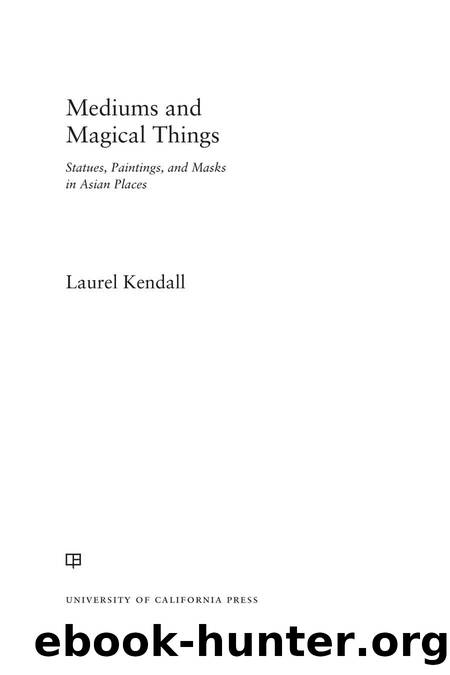Mediums and Magical Things: Statues, Paintings, and Masks in Asian Places by Laurel Kendall

Author:Laurel Kendall
Language: eng
Format: epub
Publisher: University of California Press
FIGURE 18. A mansin manifesting a General stands on blades for chopping fodder, Uijeongbu, South Korea, 1977. Devoted clients steady the blades with papers in their mouths to maintain purity. Photo: author.
These are passing moments, and things not all mansin accomplish with the same panache. What every mansin must do is convincingly manifest a range of deities, one after the other, become the presence of an imperious general, a greedy lesser official, a flighty maiden, a tearful ancestor, a mischievous child. With face and voice and appropriately costumed body, she speaks and acts as a god would speak and act, and with the godsâ authority, she creates an efficacious ritual theater where clients are chastised for past neglect and then promised the opening of an auspicious path. At the ritualâs conclusion, the mansin casts away ghosts and ill humors that heretofore blocked the clientâs path, and when necessary, sends dead souls to the Lotus Paradise, a journey that benefits both the living and the dead. A skilled and inspired mansin causes participants to experience these things within the ritual theater of a kut (Kendall 1985; 2009).
For the mansinâs part, evoking gods in kut is not a one-on-one possession. It is not so simple, and in the mansinâs view, not so easy. A mansin must actively engage and manifest her gods, even so far as putting words and gestures to their intentions. Within the ritual space of a kut, the mansin acts prosthetically on behalf of her gods, becoming the operable agent of their intentions, but not their puppet, a metaphor often applied to spirit mediums (plate 21). The mansin performs the gods into presence through divine inspirationâthrough a variety of aural and visual cues, including visions, vivid dreaming, and bodily sensations such as hunger, weakness, or rageâand sometimes inspiration is absent or insufficient. One aspiring shaman, Auntie Cho, told me with great frustration how full inspiration had long eluded her; she was a visionary, but she lacked the ability to put words to what she saw. âA friend of mine asked me to divine for her, and when I did, I could see everything, even to the graves of her ancestors. But a shaman has to have sense; she has to know how to put it all together, everything about all the clientâs kith and kin [to make a convincing divination]â (Kendall 2009, 25).
When the godsâ intentions are unclear or ambiguous, the mansin must improvise. In footage captured by Diana Lee and myself for our film An Initiation Kut for a Korean Shaman, when the initiate falters, the experienced shamans tell her bluntly, âHey, do you think some god is really going to move your tongue for you?â (Lee and Kendall 1991; Kendall 2009, 82). This was not an invitation to charlatanry. If the mansin got it wrong, if she did not faithfully transmit the will of the gods, she and her clients would be punished by dissatisfied gods. Even without a clear transmission, the mansin must get it right, perform it right.
Download
This site does not store any files on its server. We only index and link to content provided by other sites. Please contact the content providers to delete copyright contents if any and email us, we'll remove relevant links or contents immediately.
Papillon by Henry Charrière(792)
Watercolor With Me in the Forest by Dana Fox(588)
The Story of the Scrolls by The Story of the Scrolls; the M(552)
This Is Modern Art by Kevin Coval(456)
A Theory of Narrative Drawing by Simon Grennan(453)
Frida Kahlo by Frida Kahlo & Hayden Herrera(444)
Boris Johnson by Tom Bower(441)
Banksy by Will Ellsworth-Jones(434)
AP Art History by John B. Nici(428)
Van Gogh by Gregory White Smith(424)
Draw More Furries by Jared Hodges(422)
The Art and Science of Drawing by Brent Eviston(420)
Glittering Images: A Journey Through Art From Egypt to Star Wars by Camille Paglia(416)
War Paint by Woodhead Lindy(411)
Scenes From a Revolution by Mark Harris(410)
100 Greatest Country Artists by Hal Leonard Corp(390)
Ecstasy by Eisner.;(386)
Young Rembrandt: A Biography by Onno Blom(370)
Theater by Rene Girard(353)
